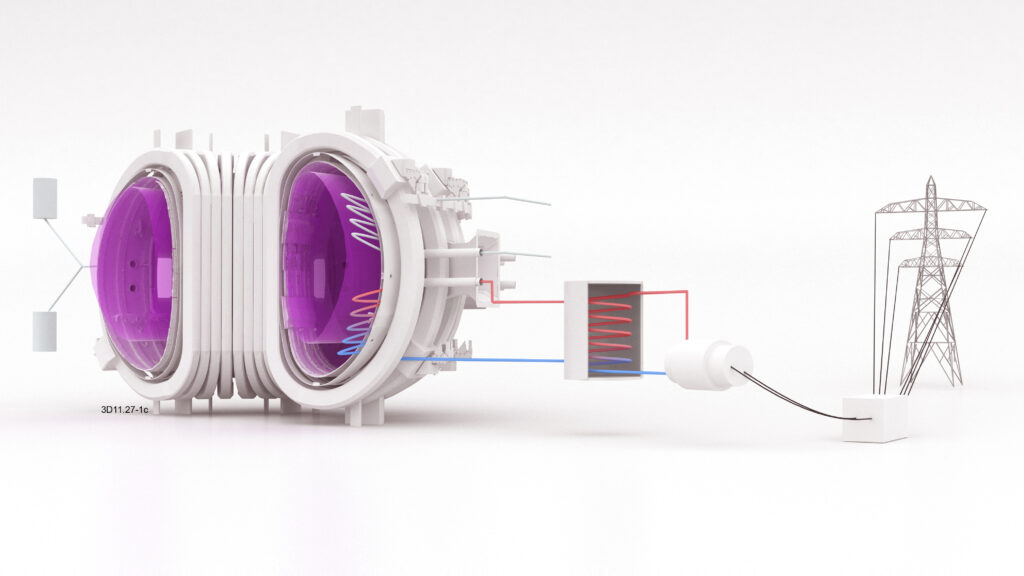Demonstration Power Plant DEMO
.
The demonstration power plant: DEMO
Designing with an eye on the future
Current fusion experiments were primarily designed to investigate plasma physics. However, DEMO must demonstrate the necessary technologies not only for controlling a more powerful plasma than has previously existed, but for safely generating electricity consistently, and for regular, rapid, and reliable maintenance of the plant. The design of such a plant must take account, not just of physics requirements, but also of engineering and technological limitations.
Considerations for a conceptual design
While the central requirements for DEMO lie in its capability to generate between 300 Megawatt to 500 Megawatt net electricity to the grid and to operate with a closed fuel-cycle, meaning spent tritium fuel will be reprocessed, the Fusion Technology team is looking at requirements that will lay the foundation for a robust conceptual design:
- Selecting the right breeding blanket. Blankets are the internal components of the reactor wall that absorb the energy from the fusion reaction, ensure the tritium breeding process and shield the components outside the reaction chamber from the fast fusion neutrons.
- Selecting the right divertor concept.
- The right design for the first-wall, the innermost lining of the reactor wall, and its integration into the blanket must take into account that the first-wall might see higher heat loads than assumed in experimental settings.
- Selecting the minimum pulse duration of DEMO and of the corresponding mix of plasma heating systems.
- Designing in a way that all maintenance work can be carried out remotely via manipulators.
- Incorporating nuclear safety issues from the very beginning of conception.

f
DEMO & the Roadmap
Central requirement
Between 300 Megawatt to 500 Megawatt net electricity
Work Programme on Socio-Economic Studies in Fusion Research
The EUROfusion programme, adhering to Mission 7 of the European Research Roadmap for Fusion Energy Realisation, extends beyond technical studies for DEMO design to encompass research on the economic and social dimensions of nuclear fusion.
In the global effort to mitigate climate change, low-carbon electricity generation technologies, such as nuclear fusion, are crucial. Nuclear fusion stands as a highly promising option, offering a stable source of carbon-free electricity to future energy systems, thereby enhancing their sustainability and reliability. However, the journey towards commercialising nuclear fusion poses significant scientific and technological challenges, demanding a collective effort from the scientific community. Alongside these challenges, factors like social acceptance and economic viability are equally important.
Beginning in 2001 under the European Fusion Development Agreement (EFDA) and continuing since EUROfusion’s establishment in 2014, there has been a concerted effort to bring together European researchers from a broad spectrum of disciplines, including physical sciences, engineering, economics, and socio-environmental studies. This interdisciplinary approach aims to identify the socio-economic conditions necessary for the successful integration of fusion into future energy markets.
The EUROfusion Work Programme on Socio-Economic Studies (WPSES) utilises tools such as global energy scenarios and comprehensive European surveys to examine future prospects and current perceptions. These tools provide diverse thematic and temporal insights, essential for offering scientific evidence to stakeholders, thereby informing strategies that support nuclear fusion development.
Within WPSES, two extensive surveys, each involving 20,000 participants across Europe, have been conducted to gauge public attitudes towards fusion. The first, carried out in 2018, is detailed in Christopher R. Jones’s paper (“Predicting attitudes towards fusion energy in Europe: Results of a cross-national public survey in Austria, Finland, Spain, and the UK,” Energy Research & Social Science, https://doi.org/10.1016/j.erss.2021.102028). The findings of the second survey, conducted in November 2023, will soon be available on this website.
